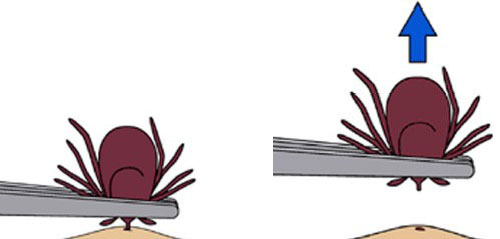Thank you for joining our email list! See our complimentary Tick Bite Blueprint below!
Introduction: Why Is the Tick Bite Blueprint Important?
Listen to Sara Brunner below on the Tick Boot Camp Podcast describe the importance of our Tick Bite Blueprint!
It is natural to feel panic when you find a tick on your body. Take a few seconds to take some deep breaths. We recommend 8 deep breaths in through your nose, out through your mouth. This will change your brain out of panic mode and into its calmer thinking mode. Your success during the next two steps depends on this.
Your goal is to remove the tick as quickly as possible. Do not wait for it to detach on its own. Also, do not attempt to do anything like “paint” the tick with nail polish or petroleum jelly, or use heat to make the tick detach from the skin. Watch This Video for Help
- Use fine-tipped tweezers to grasp the tick as close to your skin as possible
- Pull upward with steady, even pressure
- Don’t twist or jerk the tick; this can cause its mouthparts to break off and get stuck in the skin
- If this happens, do your best to remove the mouthparts with tweezers and schedule an appointment with a dermatologist

Save the tick by putting it in a closed container such as a jar or Ziploc bag. The type of tick, amount of time it was on you, bacteria, and viruses carried by the tick are all significant and testable.
After removing the tick, clean your hands with soap and water. Clean the area with a Betadine wipe (Povidone Iodine) immediately followed by an alcohol wipe. Mix bentonite clay with water until a paste forms and put it over the tick bite location. After the bentonite clay falls off a few hours after application, apply a triple antibiotic gel every 12 hours for 3 days. Do not use Betadine if you are allergic to iodine, have a thyroid condition, or if you are pregnant or breastfeeding.
Use a pen to draw a circle around the area of your tick bite.
Take a clear, close-up picture of the area where the tick bit you so that you can compare it to pictures you will take in the future.
Write down the exact place and date that you found the tick biting you.
Schedule an immediate appointment with a doctor.
Take a clear, close-up picture of your tick. Upload your tick picture to TickSpotters at the TickEncounter Resource Center for a free tick report.
Send your tick to a trustworthy tick testing service. We recommend TickReport run by Professor Stephen Rich or ECO Laboratory run by researcher Karen Weeks.
Learn more about TickReport on our interview with Professor Stephen Rich or learn more about ECO Laboratory on our interview with researcher Karen Weeks.
There are also free options for tick testing:
There are multiple types of tests for tick diseases, such as:
- Blood tests
- Urine tests
- Fluid tests (spinal fluid, joint fluid, etc.)
- Tissue tests
There are several tick disease testing methods:
- Immune response or antibody tests; for example the ELISA / EIA and Western Blot tests
- Tick microbe DNA test; for example, PCR test
Be sure to ask your doctor for a full tick-borne disease panel, not just a Lyme Disease test. Remember, Lyme Disease and other tick disease tests are not perfect. In fact, the traditional tests run by most doctors are only about 50% accurate. If you are exhibiting symptoms after a tick bite and your tests come back negative, consider using a private lab with more accurate testing techniques such as:
At the end of each day, write down any physical or emotional symptoms you are experiencing so you can compare how you have been feeling since your tick bite (The Tick Boot Camp Journal may be a helpful tool).
Take a picture of where the tick bit you each day. Compare it to pictures of the tick bite location that you took from earlier days. Do this for at least 30 days.
Do a full-body skin review each day. Write down and take pictures of any changes in color on your skin or rashes that you have anywhere on your body. The rash doesn’t have to be exactly where the tick bit you. It also doesn’t have to be a bullseye rash. Look at our Instagram story highlight titled “Lyme Rash” to see examples of different types of rashes.
Give all of the information that you gathered above to your doctor. Discuss preventative treatment options such as antibiotic and herbal treatments. (Note: the Lyme bacteria lifespan is 30 days). Also discuss testing for potential tick diseases.
Additionally, in his article, “How to Build a Positive Relationship with your Doctors,” Dr. Bill Rawls, MD, suggests using the following guidelines to have a more positive and productive relationship with your doctor.
Collect medical records from your primary care doctor; including all tests.
Use reports that you got from TickSpotters and the tick testing company that you used to make sure you are fully aware of possible symptoms. Have you developed any symptoms? If so, LymeDisease.org has a checklist that helps you document your exposure to Lyme Disease and common symptoms for your doctor. Visit their Lyme Disease Symptom Checklist page and select the Lyme disease symptoms and conditions that apply to you or your child. You will get an email with a PDF attached that you can print out and take with you to your doctor’s appointment. Share your checklist responses with your doctor to determine if you or your child have Lyme disease.
- International Lyme and Associated Diseases Society (ILADS) (you must register for a free account)
- LymeDisease.org
- Use one of the links below to secure a recommendation from a local Lyme Disease support group:
NOTE: The Tick Bite Blueprint is a crowd-sourced document created with input from guests that have appeared on the Tick Boot Camp Podcast. We thank each guest for their contribution, and we request your input. If you have any recommendations that can improve this Tick Bite Blueprint, please contact us online.
